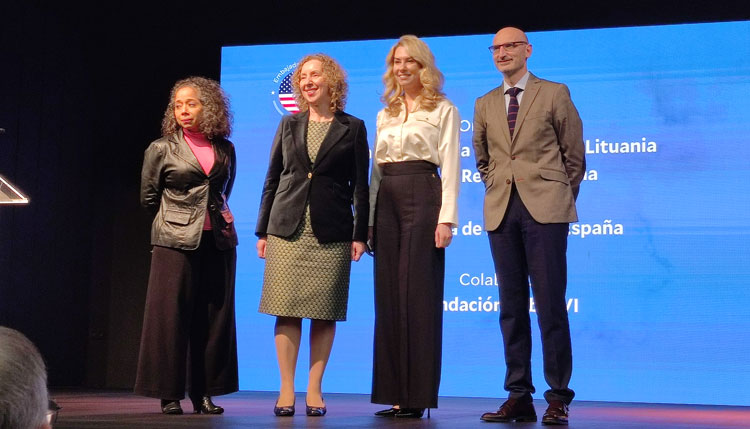Juan David Latorre
With the presence of the film’s director, Giedrė Žickytė, the Ambassadors of Lithuania, Lyra Puišytė-Bostroem, and of the United States, Julissa Reynoso, organised last Tuesday the screening of The Jump at the Espacio Pablo VI in Madrid. Jesús Avezuela Cárcel, director of the Pablo VI Foundation, was the host and introduced the guests.
The film tells the story of a Thanksgiving Day in 1970. The United States Coast Guard approaches a Soviet ship anchored off Martha’s Vineyard Island. The two world powers have agreed to meet to discuss fishing rights in the Atlantic Ocean. While the talks are underway, Lithuanian sailor Simas Kudirka jumps onto the American ship. The jump triggers a series of chaotic events and provokes a colossal conflict in the midst of the Cold War. The US denied his request for political asylum and Kudirka returned to the Soviet Union accused of treason. The Richard Nixon administration saw protests for Kudirka’s release spread across the country.
After breaking the news that director Giedrė Žickytė had just received the Lithuanian National Prize for Culture and Arts, Ambassador Lyra Puišytė-Bostroem said that she had met the director six years ago in Washington, where she had gone to research her new project, the film The Leap. “I was fascinated by her enthusiasm, she said, her very responsible attitude towards history. She spent days and days in the archives, researching and preparing to tell this incredible story.”
Lyra Puišytė-Bostroem highlighted the courage and bravery of the Lithuanian sailor. “It is these acts that helped bring down the totalitarian regime of the Soviet Union, in an occupation of Lithuania that lasted 50 years, but we never, never stopped resisting. Another regime, Putin’s regime, the ambassador continued, will not be able to destroy the identity and courage of the Ukrainian people.”
“The big difference between a democratic country and an authoritarian one is the ability to recognise a mistake, to apologise and to try to do everything possible to correct it, and this is what the United States did with sailor Simas Kudirka.”
For her part, US Ambassador Julissa Reynoso said, “This film tells Kudirka’s story of finding a better life outside the Soviet Union. It is a story about our important obligations as democracies to accept migrant refugees. A story about the power of collective action, in which the American people put pressure on their government to change its policy and save the life of the Lithuanian sailor.”
“In the year 2020,” the ambassador commented, “there were 281 million refugees in the world, citizens not living in their country of birth, 128 million more than in the year 1990, more than triple the number estimated in 1970. That is why President Biden, since taking office, has prioritised building a fair and orderly immigration system, and we are working with countries around the world to do that. The United States remains a place of refuge for people who seek opportunity, who want to be reunited with their families, and who seek safety and freedom. We have resettled more refugees than any other country in the world.”
“We believe that an open society,” Julissa Reynoso finished, “a civil society that can put pressure on its government, can change the world, as demonstrated by the story of this film. For this reason, the United States, along with our allies Lithuania and Spain, must continue to press for freedom of expression and assembly, the protection of human rights and democratic values around the world.”
Through the first-person accounts of those who witnessed the jump, previously unpublished archival footage and the hilarious recreations of Kurdirka himself – now 90 years old and with an unforgettable sense of humour – director Giedrė Žickytė builds an inspiring story with incredible twists and turns, reflected in a film that is enjoying continued success in every country where it is shown.







